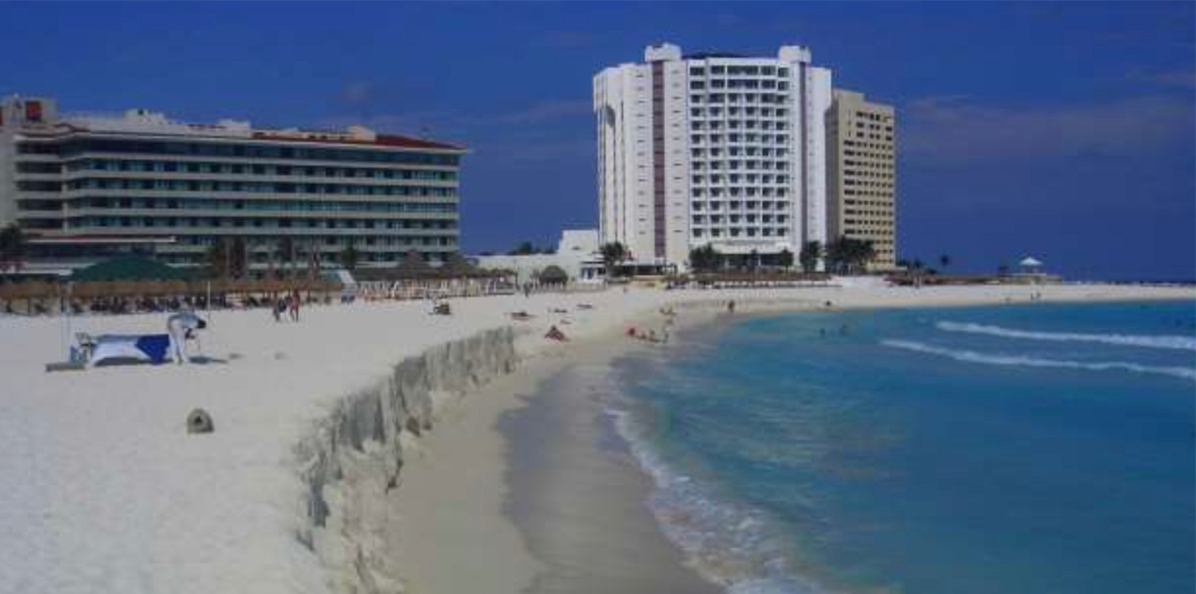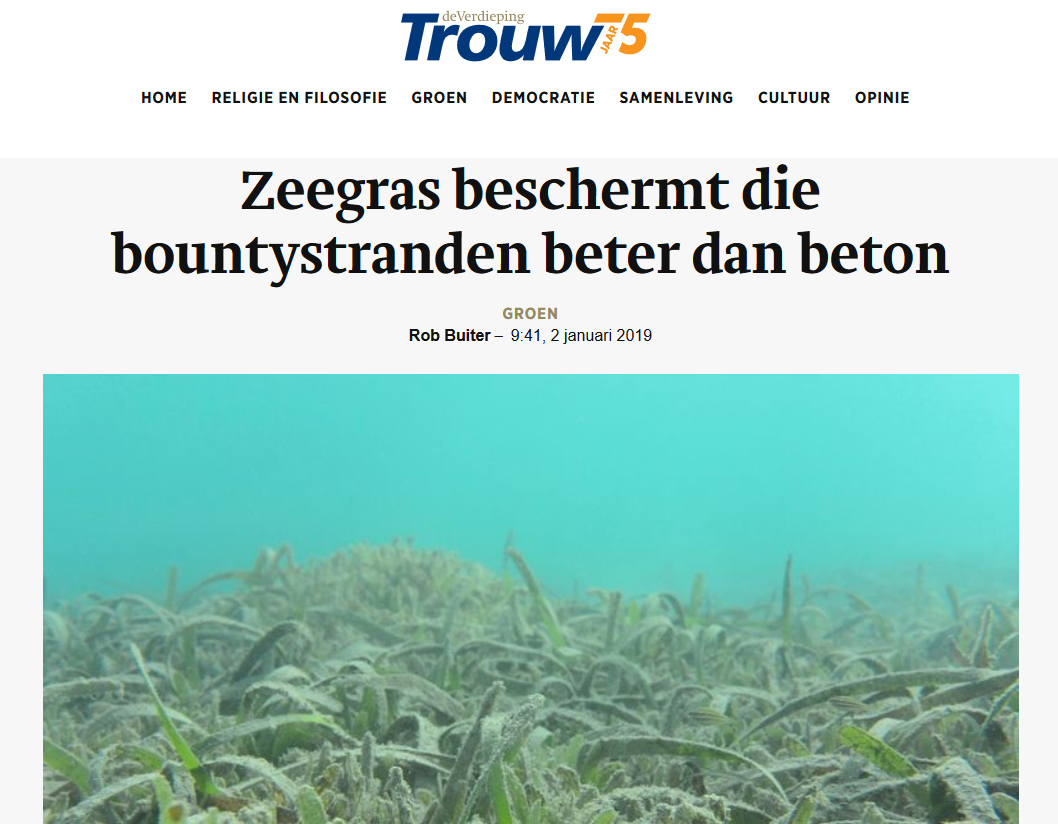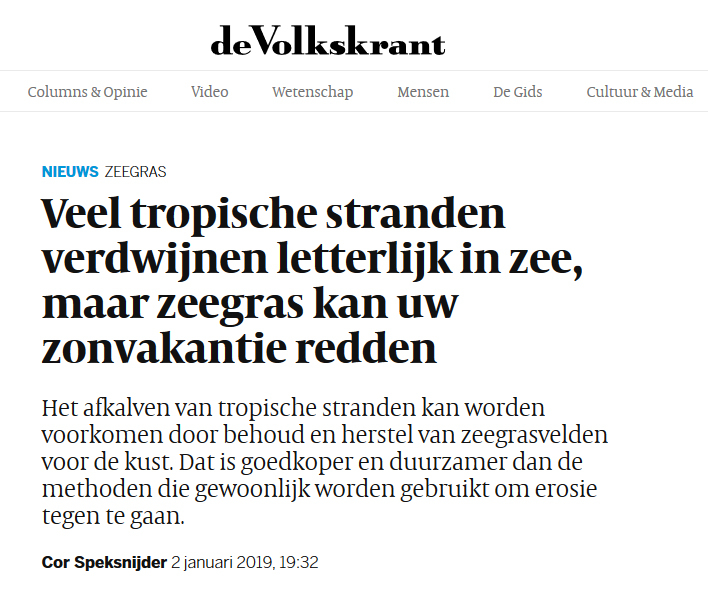Zeegras spaart stranden en geld

Erosie neemt toe met veranderend klimaat
In hun onderzoek richtten de auteurs zich met name op het Caribisch gebied, waar bijna een kwart van het Bruto Binnenlands Product uit toerisme komt, voor een groot deel op en rond de stranden. “Maar met de enorme toename van bebouwing langs de kusten, waarbij de natuurlijke stroom van water en zand wordt verstoord, zijn veel stranden in deze regio al in de zee verdwenen”, stelt professor Rodolfo Silva, hoogleraar kustwaterbouwkunde aan de Universidad Nacional Autónoma in Mexico, een van de co-auteurs van het artikel. "Tot nu toe worden vooral dure kunstmatige ingrepen gedaan om deze erosie te bestrijden, zoals dure zandsuppleties en de bouw van betonnen zeewering. Door de toename van extreem weer en de stijging van de zeespiegel met het veranderende klimaat, zal het probleem van erosie alleen maar groter worden."
Experimentele stroomgoot
Om te ontdekken hoe goed een zeegrasveld zand en sediment kan vasthouden, deden James en haar promotor, professor Tjeerd Bouma (NIOZ en Universiteit Utrecht) een even simpel als doeltreffend experiment in een Caribische baai, op stukken bodem met en zonder zeegras. Met behulp van een draagbare en nauwkeurig instelbare stroomgoot, keken zij bij welke stroomsnelheid de bodemdeeltjes werden weggespoeld. "Het bleek dat gezond zeegras bijzonder effectief is in het vasthouden van bodemdeeltjes", zag James. "Dat betekent dat een vooroever met zeegras, zeker in combinatie met specifieke algen die kalk-zand produceren een natuurlijke kustverdediging vormt die zijn eigen “zand” creëert en vasthoudt."
Meer zeegras is minder erosie
Langs de kusten van het Mexicaanse schiereiland Yucatan keken de onderzoekers of deze theorie ook in de praktijk werkt. "Wanneer wij de stranden met en zonder een gezonde vegetatie vergelijken, zien we dat de erosie sterk samenhangt met de hoeveelheid zeegras: hoe meer zeegras, hoe minder erosie", stelt dr. Brigitta van Tussenbroek van de Universidad Nacional Autónoma in Mexico. "Op plekken waar het zeegras verdwijnt, zie je een plotselinge sterke toename van de erosie, waardoor vaak dure zandsuppleties nodig zijn."
Veelbelovende techniek
Zowel natuurbeschermers als waterbouwers hebben enthousiast gereageerd op het onderzoek. "Tot nu toe worden zeegrasvelden vaak als een sta-in-de-weg gezien, terwijl ze feitelijk van groot belang zijn voor de kustbescherming. Dit onderzoek helpt het beeld recht te zetten en toont aan dat natuur een bondgenoot waar we heel zuinig mee om moeten gaan", zegt Bas Roels van het Wereld Natuur Fonds Nederland. "Het onderzoek opent nieuwe mogelijkheden om tropische stranden te beschermen door technieken waarbij de ecologie een centrale plaats inneemt", zegt Mark van Koningsveld, professor aan de TU Delft en werkzaam bij waterbouwer Van Oord.
In het Caribisch gebied staat zeegras onder steeds meer onder druk, ook rond de Antillen. "Voor een deel komt dat door vervuiling vanaf het land en invasieve soorten", zegt co-auteur Johan Stapel van het Caribbean Netherlands Science Institute (CNSI) op St. Eustatius. Dat eerste probleem is aan te pakken met voldoende geld en politieke wil, maar de mogelijkheden voor landschapsherstel zijn er. Bouma concludeert: "NIOZ heeft al veel succeservaringen met het restaureren van kustvegetatie, van mangroven tot zeegras."
Artikel:
James, Rebecca.K et al.
Maintaining Tropical Beaches with Seagrass and Algae: A Promising Alternative to Engineering Solutions.
DOI: 10.1093/biosci/biy154
Seagrass saves beaches and money
Seagrass beds are so effective in protecting tropical beaches from erosion, that they can reduce the need for regular, expensive beach nourishments that are used now. In a recent article in the journal BioScience, biologists and engineers from The Netherlands and Mexico describe experiments and field observations around the Caribbean Sea. "A foreshore with both healthy seagrass beds as well as calcifying algae, is a resilient and sustainable option in coastal defense", says lead author Rebecca James, PhD-candidate at the University of Groningen and the Royal Dutch Institute for Sea Research (NIOZ), The Netherlands. "Because of erosion, the economic value of Caribbean beaches literally drains into the sea."

Increasing erosion with climate change
The authors looked at beaches of the Caribbean Sea, where almost a quarter of the Gross Domestic Product is earned in tourism, mainly around the beaches. "With the increase of coastal development, the natural flow of water and sand is disrupted, natural ecosystems are damaged, and many tropical beaches have already disappeared into the sea", co-author Rodolfo Silva, professor of Coastal Engineering at the Universidad Nacional Autónoma of Mexico says. "Until now, expensive coastal engineering efforts, such as repeated beach nourishments and concrete walls to protect the coast, have been made to combat erosion. Rising sea-level and increasing storms will only increase the loss of these important beaches."
Experimental field flume
To find out to what extent seagrass beds are able to hold sand and sediment on the beach foreshores, James and her promotor, professor Tjeerd Bouma (NIOZ and Utrecht University), conducted a simple but telling experiment. With a portable and adjustable field flume to regulate water motion in a Caribbean bay, they observed when particles on the sea bed started moving. "We showed that seagrass beds were extremely effective at holding sediment in place", James says. "Especially in combination with calcifying algae that "create their own sand", a foreshore with healthy seagrass appeared a sustainable way of combating erosion."
More seagrass, less erosion
Along the coastline of the Mexican peninsula of Yucatan, the team put their theory to the test. "By looking at beaches with and without protection of healthy seagrass beds, we showed that the amount of erosion was strongly linked to the amount of vegetation: more seagrass, meant less erosion", co-author dr. Brigitta van Tussenbroek of the Universidad Nacional Autónoma in Mexico says. At beaches where seagrass beds were destroyed, the researchers saw a sudden strong increase in erosion, resulting in an immediate need of expensive beach nourishments.
Promising future prospects
Both NGO's and engineering industry welcome these novel insights. "To date, seagrass beds are too often regarded as a nuisance, rather than a valuable asset for preserving touristically valuable coastlines. This study could change this perspective completely", Bas Roels of World Wildlife Fund Netherlands says. "The study opens opportunities for developing new tropical-beach protection schemes, in which ecology is integrated in engineering solutions", adds Mark van Koningsveld, professor at the Delft University of Technology and working for the international marine contractor Van Oord.
According to co-author Johan Stapel of the Caribbean Netherlands Science Institute (CSNI) on St. Eustatius this will require a multilateral approach in conservation and restoration, as seagrass faces increasing pressure from various sources of pollution and invasive species. "Fortunately, NIOZ has a strong tradition in successfully restoring all kinds of coastal vegetation from seagrass to mangroves", Bouma concludes.
Article
James, Rebecca.K et al.
Maintaining Tropical Beaches with Seagrass and Algae: A Promising Alternative to Engineering Solutions.
DOI: 10.1093/biosci/biy154
The research was been carried out by marine scientists from the Netherlands (NIOZ, Utrecht University, Radboud University Nijmegen, Technical University Delft and Deltares) and Mexico (Universidad Nacional Autónoma de México) and St. Eustatius (Caribbean Netherlands Science Institute)


